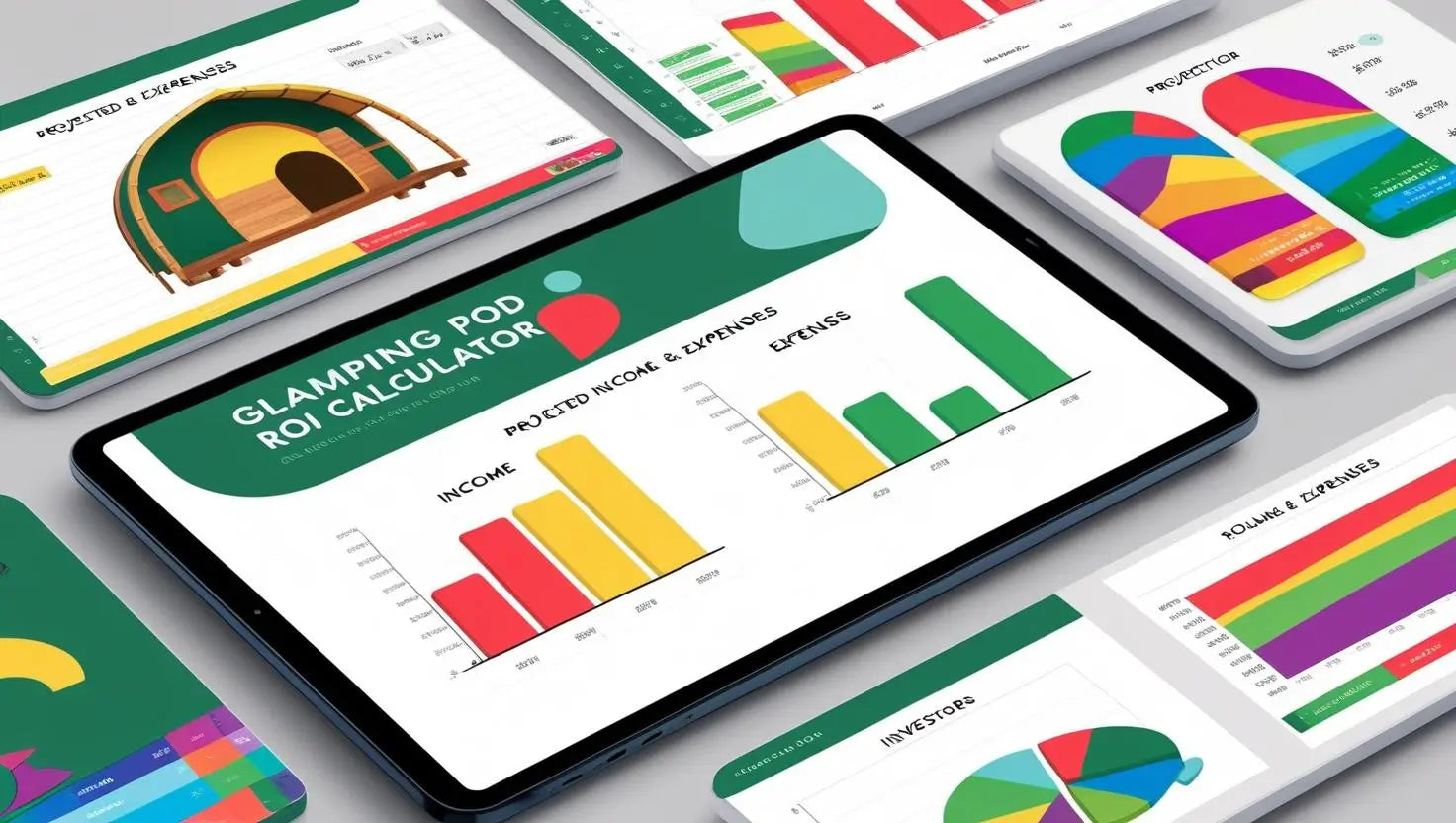Read Time: 8 mins

Power is one of the most important considerations when setting up a glamping pod. Guests expect hot showers, cosy lighting, and the ability to charge their devices, even when your site is far from the mains. The question is: how do you deliver these comforts sustainably and without the headache of high infrastructure costs?
That’s where combining solar power with LPG (propane gas) comes in. This hybrid approach is already trusted by glamping operators across the UK because it’s affordable, reliable, and beginner-friendly.
In this guide, we’ll explore how solar and LPG complement each other, what each system does best, the essential kit you’ll need, and how much to budget. This blog is designed to give both new pod owners and experienced operators clear, practical advice to build an off-grid setup that works all year round.
What Solar Does for Your Pod
Solar is your pod’s silent source of everyday electricity. It works by capturing sunlight with panels, storing that energy in batteries, and then making it available for lights, gadgets, and small appliances. In practice, this means your guests can enjoy cosy LED lighting, charge their phones, and keep a small fridge running, all without ever hearing a generator.
The beauty of solar is that it runs quietly in the background, topping up your batteries during the day so you’ve always got power at night. It’s low-maintenance, sustainable. Once installed, it is completely free to run.

What LPG Does for Your Pod
Where solar struggles, LPG steps in. LPG (propane gas) delivers instant, high-heat energy, which is exactly what you need for cooking, hot water, and keeping your pod warm in winter. These are the jobs that would drain a battery bank in no time if you tried to do them with electricity alone.
With a simple gas setup, you can boil a kettle in minutes, give guests proper hot showers, and keep the cabin snug through frosty nights, all at a fraction of the cost of upsizing your solar system. That’s why most successful off-grid sites still rely on LPG as their heat source.

Solar vs LPG: Finding the Right Balance
Running a pod off-grid isn’t about picking one energy source over the other, it’s about knowing which tool is best for each job. By dividing the workload smartly, you avoid overspending on panels and batteries, and you keep your pod running smoothly in every season.
| Task / Appliance | Best Power Source | Why |
| Indoor & outdoor lighting | Solar (battery + LED) | Very low draw; easy to run all night. |
|
Charging phones & laptops |
Solar (battery/inverter) | Low, steady demand; solar handles it quietly. |
| Water pump (sink/shower) | Solar (battery) | Short bursts of moderate power. |
| Mini-fridge or cool box | Solar (battery) | Efficient 12V compressor models run continuously. |
| Cooking (hob, kettle, oven) | LPG (propane) | High heat output; avoids draining batteries. |
| Space heating | LPG (furnace or heater) | Heating needs thousands of watts, ideal for gas. |
| Water heating | LPG (instant heater) | On-demand hot water without huge electric load. |
| Backup power/generator | LPG (dual-fuel gen) | Keeps batteries topped up during cloudy weeks. |
Why Solar and LPG Work Better Together
A successful off-grid pod isn’t about choosing between solar and LPG, it’s about letting each one do what it does best. Solar delivers quiet, renewable power for everyday use, while LPG provides the reliable backup for high-demand jobs. When you pair them, you avoid the cost of oversizing your solar setup and the limitations of relying on gas alone.
The payoff? A balanced system that’s affordable to install, simple to manage, and comfortable for guests in every season.
Recommended Products for a Solar + LPG Setup (UK)
Choosing off-grid equipment can feel daunting, so here are three tried-and-tested options for each system. These are beginner-friendly, widely available in the UK, and suited to powering a small glamping pod.
Top 3 Solar Picks
• Renogy 200W 12V Solar Kit - ~£299.99: A simple, expandable starter kit with two 100W panels and an MPPT charge controller. Ideal for lighting, device charging, and a mini fridge.
• Renogy 100Ah LiFePO₄ Battery - ~£189.90: Lithium batteries last 3–4 times longer than lead-acid and are lighter, maintenance-free, and more efficient, perfect for year-round pods.
• Sunshine Solar 1000W Pure Sine Inverter - ~£173.25: Provides safe 230V AC power for laptops, TVs, and small appliances. Compact, reliable, and sized well for pods.
Alternative for beginners: The Jackery Explorer 500 (~£230) is an all-in-one portable power station, just add a solar panel. Great if you want plug-and-play simplicity.
Top 3 LPG Picks
• Thetford Topline 922 (2-Burner Hob) - ~£240: A compact, built-in LPG hob that makes pod cooking feel like home. Runs directly from a propane bottle.
• Camplux 5L Portable Instant Water Heater - ~£120: Delivers 5 litres per minute of hot water on demand, ideal for showers and sinks. Lightweight, easy to mount outdoors or in a vented space.
• Propex HS2000 Vented LPG Heater - ~£632.50: A safe, thermostatic gas furnace that keeps pods warm through winter. Compact and efficient, designed for small cabins and caravans.
Backup option: The Champion 2200W Dual-Fuel Inverter Generator (~£529.99) can run on propane or petrol, keeping batteries topped up during long cloudy spells.
Setup, Maintenance & Safety Tips
Setting up an off-grid power system is doable for beginners, but safety and routine care are key.
• Solar panels: Face them south at a tilt of ~30–50°. Keep them clear of shade, and wipe dust or pollen off every few weeks.
• Wiring: Use thick 12V cables and fuse every circuit to prevent overheating or fire risks. Many kits include diagrams and pre-fused leads.
• Batteries: Keep lead-acid batteries in a ventilated box (they can release gases). Lithium doesn’t off-gas, but still store in a stable temperature.
• Inverters: Switch them on only when you need AC. Run as much as possible on 12V (USB charging, LED strips, pumps) to save energy.
• Gas appliances: Mount securely and use proper copper or high-pressure hoses. Fit drop-out floor vents for LPG, and get a Gas Safe engineer to check any permanent installs.
• Safety gear: Install a carbon monoxide alarm, smoke alarm, 2kg dry powder extinguisher, and a fire blanket near the cooking area.
• Routine checks: Each season, clean panels, inspect wiring, test alarms, and check gas hoses for cracks or leaks (use soapy water). If you have a generator, run it monthly and change the oil as directed.
Managing Your Off-Grid Power Usage
Living off-grid is all about balance. A little awareness goes a long way to keeping your pod running smoothly.
• Monitor your battery: Most charge controllers show charge levels; a battery monitor gives even clearer readings.
• Time high-power tasks: Use appliances like blenders or pumps at midday when panels are generating, not at night when you’re relying on stored energy.
• Avoid “power hogs”: Hairdryers, toasters, kettles, and microwaves (1,000–2,000W) will drain a small battery fast. Use LPG alternatives: a stovetop kettle, French press, or gas toaster.
• Get creative with lighting: 12V LED strips or fairy lights sip power and add atmosphere. Outdoor solar lanterns charge themselves and keep the mood magical.
• Plan for bad weather: A decent battery bank covers a couple of rainy days. For longer spells, keep a backup generator, extra battery pack, or a way to recharge from a vehicle.
Guests usually adapt quickly, and many enjoy the slower, more intentional pace of off-grid living. It becomes part of the glamping charm.

Pod Recommendations
If you’re planning to go off-grid, the pod you choose is just as important as your energy setup. At GlampLaunch, all our models are designed to work seamlessly with solar and LPG systems, so you can create a sustainable and guest-ready retreat from day one.
• The Mega Hobbit Pod – £57,785 (ex. VAT): Spacious and eye-catching, perfect for offering a premium guest experience. (This is our newest product so contact us for more information)
• Log Cabin – £51,995 (ex. VAT): Classic lodge style with ample room, perfect for families or group stays. (This is our newest product so contact us for more information)
• Shepherd’s Hut – £46,247.50 (ex. VAT): A traditional design with modern comfort, great for year-round use. (This is our newest product so contact us for more information)
• GlampTainer – £24,995 (ex. VAT): A versatile and budget-friendly option, ideal for first-time site owners. (This is our newest product so contact us for more information)
All pods are built from sustainably sourced timber and crafted to last, making them a smart investment for both comfort and sustainability.
Conclusion
Powering a glamping pod off-grid is absolutely achievable, even for beginners, and it doesn’t have to cost the earth. By letting solar handle everyday electricity and LPG take care of the heat-heavy jobs, you create a hybrid energy system that’s resilient, affordable, and comfortable all year round.
The key is to start simple: a modest 200W solar setup with a couple of LPG appliances is enough to provide lighting, charging, hot water, and cooking. From there, you can scale up with more panels, batteries, or additional features as your site grows. Even the basics deliver a surprisingly luxurious experience for guests.
At GlampLaunch, our pods are designed with this flexibility built in. Each one can be fitted with integrated solar and LPG systems, so you’re ready for off-grid living from day one. Plus, because we build with sustainably sourced timber and long-lasting materials, you reduce running costs while also minimising your environmental footprint.
Learn more about how we build our sustainable luxury pods.
Ready to explore how solar and LPG can work for your site? Book a meeting with Taylor to talk through your plans and see how GlampLaunch can help bring your off-grid pod project to life.
Summary
• Guests expect reliable hot showers, lighting, and device charging even at off-grid glamping sites.
• Solar power covers low-draw needs like lighting, charging, pumps, and fridges, running quietly and sustainably.
• LPG (propane) is ideal for high-demand uses such as cooking, water heating, and space heating.
• A hybrid solar + LPG setup balances costs, avoids oversized systems, and ensures comfort in every season.
• Starter solar kit example: 200W panels, 100Ah battery, and a 1,000W inverter; scalable as demand grows.
• Key LPG appliances include hobs, instant water heaters, and compact furnaces for winter warmth.
• Safety is essential: fuse solar wiring, ventilate batteries, fit CO and smoke alarms, and check LPG hoses regularly.
• Pods designed for off-grid living integrate insulation, renewable energy compatibility, and sustainable materials.
• GlampLaunch pods are built to work seamlessly with hybrid systems, ensuring long-term comfort, resilience, and guest appeal.
FAQs
1. How can I power a glamping pod off-grid in the UK?
The most reliable solution is to combine solar power and LPG (propane gas). Solar panels and batteries provide quiet, renewable energy for lights, charging devices, and small appliances, while LPG covers high-demand tasks like cooking, hot water, and space heating.
Together, they create a balanced system that’s sustainable, affordable, and guest-friendly.
2. What appliances should run on solar, and which are better with LPG?
Use solar for low-demand tasks such as LED lighting, charging phones or laptops, running a water pump, or powering a mini-fridge.
Switch to LPG for heat-heavy jobs like boiling kettles, cooking, heating pods, and supplying on-demand hot water. This division avoids draining your batteries while keeping energy costs low.
3. How much does an off-grid solar and LPG setup cost for a pod?
A basic starter system can be built with:
Solar setup
• Renogy 200W 12V Solar Kit – ~£139.99
• Renogy 100Ah LiFePO₄ Battery – ~£189.90
• Sunshine Solar 1000W Pure Sine Inverter – ~£173.25
LPG setup
• Camplux 5L Portable Instant Water Heater – ~£120
• Thetford Topline 922 (2-Burner Hob) – ~£240
• Propex HS2000 Vented LPG Heater – ~£632.50
Together, this covers lighting, device charging, cooking, hot water, and heating. Total costs will scale depending on pod size and guest comfort requirements.
4. Are GlampLaunch pods suitable for off-grid solar and LPG systems?
Yes. All GlampLaunch pods are designed to integrate seamlessly with solar and LPG setups. Whether you choose the Mega Hobbit Pod, Log Cabin, Shepherd’s Hut, or GlampTainer, each model can be fitted with the necessary wiring, insulation, and fixtures for sustainable off-grid living from day one.





